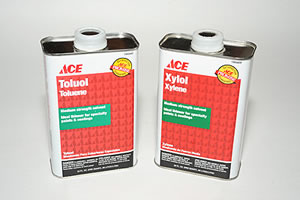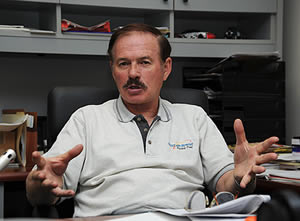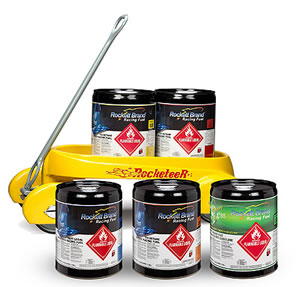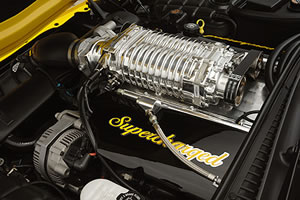Corvette Action Center Deep Dive Series: Gasoline for your Corvette - Page 6 of 8
 |
 |
Page 6 of 8
© 2009 by Hib Halverson
No use without permission, All Rights Reserved
![]() Discuss this article
Discuss this article
Blend Your Own Race Gas?

While toluene and xylene are easy to obtain at many hardware and home improvement stores, don't let their wide availability fool you. Homebrew "racing gas", while it can increase octane has other drawbacks which might cause more of a performance loss than you gain with the extra octane. Image: Author
If you're a regular reader forum web sites such as "Smokinvette" or "Digital Corvettes", you've probably heard of do-it-yourself additives said to improve gasoline. Unfortunately, a lot of that is urban legend. The executive summary of "DIY race gas" is: mixing it can be dangerous. You sometimes lose performance. You don't save money. Some of these additives are: aniline, benzene, toluene, xylene and propylene oxide. Forget the first two. Both are highly toxic. Aniline is absorbed through the skin and impairs your blood's ability to carry oxygen. Handle aniline improperly and you die. Benzene is a carcinogen, so you'll die after improperly handling it, too-it'll just take longer. Their toxicity and that they are used in making prescription drugs has aniline and benzene Federally-regulated and not generally available to the public.
The aromatic hydrocarbons ("aromatics"), toluene and xylene can be octane improvers. Significant amounts of toluene and lesser amounts of xylene are already in pump and racing gasolines. Toluene and xylene are mass-marketed to consumers by hardware stores, paint supplies and home improvement warehouses. Both are mildly toxic. Work with them wearing chemical-resistant gloves and in a ventilated area. If there's any question about ventilation, wear a respirator.
In California, law restricts aromatics to 25-35% of a gasoline blend, depending on the size of the refiner. Elsewhere, gasoline's aromatic content varies much more and can be as high as 40%. The octane boosting ability of toluene and xylene are less with premium pump gasolines than with regular grade gas because of the aromatics premium fuel already contains. Their effect on pump gas is unpredictable because they have high octane ratings alone, but may have lower octane when blended with other gasoline components. They should be tested for effect when mixed with other gasoline components.
Toluene and xylene have specific gravities higher than pump gas so the more of them you add, the leaner you need to calibrate the engine's air/fuel ratio. Once you calibrate for toluene- or xylene-spiked, DIY racing gas; don't go back to running your engine hard on conventional gasoline until you recalibrate to a richer mixture or you'll be burning pistons and valves. Both have less volatility, too, so engines burning gasoline laced with high concentrations of them may be more difficult to start when cold.
In addition to handling, mixing, calibration, drivability and performance problems associated with DIY race gas, it has a lousy business model, too. A late-model Corvette with a medium-boost, aftermarket supercharger kit at the drag races on a warm day might need 97-octane to keep the engine out of detonation. Toluene, used as a blending component, is 103.5-octane. To make 10-gallons of 97.2-octane, DIY race gas (1:1, 91-octane unleaded, at $3.59@gal, and toluene, at $17.50@gal. from Ace Hardware) costs $105.45. Do it with 91 and 100 unleaded racing gasoline ($6.49@gal), you mix 3:7 for $56.29. Because a 1:1 mix of toluene and pump gas costs you performance and throttle response due to slow burn speed; not only is DIY race gas a lot more expensive, but, while it may not knock; it won't perform as well, either.

"Adding more toluene," Rockett Brand Racing Fuel Engineer, Tim Wusz, told us, "will increase the octane numbers of the gasoline, but when you get above 45 or 50%, throttle response is poor and the flame speed is reduced to where increasing amounts of fuel are still burning as combustion gases are forced out the exhaust valve. Once that happens, power is lost, not gained." Image: Author
The economics of xylene are worse than toluene. Xylene from commercial sources is "mixed-isomer", runs about 18 bucks a gallon and has less octane boosting ability than toluene. The higher octane, "single isomer" varieties of xylene, typically obtained through science and laboratory supply businesses, are obscenely expensive, upwards of $100 per gallon.
Misunderstanding surrounds propylene oxide. Common uses for it are pesticide and fumigant. While the EPA lists it only as a "probable carcinogen," ingesting propylene oxide will at least make you sick and can cause coma or death. Use care when handling it. Some racers are under the impression "P.O." is an octane booster, but it is not. It is an oxygenate that works like nitrous oxide but not as well. "Propylene oxide will improve performance," Tim Wusz told us, "but the mixture must be richer to take advantage of that. PO is more effective than ethanol but less effective than nitrous. The downsides of PO are: 1) it attacks plastic and rubber parts in fuel systems and 2) its low, 95 deg. F boiling point gives it a tendency to easily escape from a blend leaving the DIY race gas blender with a product which he thought contained a certain amount of PO, but in reality, may have retained far less of it. This makes tuning exceedingly difficult." Bottom line: brewing your own race gas with chemicals you buy at the hardware store or wherever is a foolish move for a lot of reasons. You're better off buying it ready-made.
Racing Gas, the Real Deal:
Some think racing gasoline is just for racing but, in recent years, the term has come to mean super high-octane, unleaded which can, also, be used by street cars. The obvious reason to use race gas is higher antiknock rating, but just as important: race gas is an optimum, balanced, blend of hydrocarbons and additives intended to consistently produce the highest possible performance from a high rpm automotive engine. It's better than pump gas fortified with octane boosters, better than AvGas and better and safer than gas spiked with store-bought aromatics or oxygenates. Bottom line: if need higher octane than pump gas and you want your engine to perform best; racing gas is the only choice.
In the racing gas business, "entry-level" unleaded gasolines for automotive engines are usually about 98-oct. (R+M)/2, a noticeable gain over the 94-oct of the best pump gas and way better than the 91s which Corvetters in the western parts of the country have been stuck with in recent years.
The most widely sold racing unleadeds are all about 100-octane. Racing unleaded is the perfect choice if the engine in your Vette needs a moderate increase in octane. It is good for engines with superchargers of moderate boost, modest nitrous oxide injection systems or any modifications that increase cylinder pressure somewhat over stock levels.
We asked Tim Wusz why his Rockett Brand Racing Fuel doesn't follow the big race gas vendors and offer a 98. "Based on our market research, we felt the street performance market wanted a 100 unleaded. It's a lot cheaper to make a 98, but a 'hundred'-when you start to advertise and sell something for the street and you have a market which sees that three digit number better than a two digit number-is a better choice. We choose to keep Rockett Brand's line simple, stick with our proven 'hundred' and not add a fifth product that probably wouldn't be as attractive to the market, anyway.
"Rockett Brand 100 has been used in endurance sports car racing in four-inch bore engines with 14:1 compression ratios and aluminum heads," Wusz continued. "With cast iron heads, compression ratio should be limited to 12:1. It can be used in current performance street cars. Historic muscle cars can also benefit from this product which easily services the 11:1 compression ratios of many engines from that era."
 |
 |
Image: Rockett Brand Racing Fuel |
The best choice for modified engines with electronic controls, such as this Magnuson-supercharged LS6, is a 100-octane unleaded gas mixed with pump gas to result in the octane necessary to keep the engine out of detonation. Image: Author |
When a late-model Corvette is run hard on hot days, as shown in our tests on the SuperFlow Auto-Dyn with a 2nd-gen. ZR1 (see Part 2 of this series) and later with an '04 Z06, engine computers usually enable spark retard. This is because, since the mid-'90s, GM has calibrated spark advance for its highest-performance engines for best performance at low altitudes, in cool weather, burning 93-octane fuel, then "save" the engine with spark retard when mild detonation is sensed during high-load/hot-weather operation or when using 91-octane gas in just about anything but cold and damp weather. Because of the retard, performance is reduced and coolant temperature can be slightly higher.
 |
 |